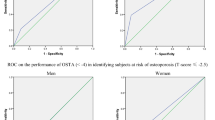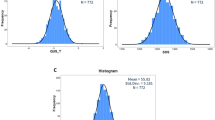Abstract
This study aims to evaluate an osteoporosis self-assessment tool for Asians (OSTA) and quantitative bone ultrasound (QUS) and their combination in detecting populations at high risk for osteoporosis, and to determine the best cutoff value for the diagnosis of osteoporosis among elderly Chinese men. A group of Chinese men, aged ≥ 60 years, recruited from the health checkup population of Zhongshan Hospital, Fudan University, were included. The OSTA index was calculated from age and weight. Bone mineral density (BMD) at left hip (femoral neck, internal, and total hip) and lumbar spine (L1–L4, L-Total) was measured with dual-energy X-ray absorptiometry (DXA), and calcaneal BMD was measured with QUS. Receiver operating characteristic analysis was used to determine the best cutoff values, sensitivity, and specificity. The area under the curve (AUC) between the different screening tools was compared. Our study included 472 men with mean age of 78.0 years. The prevalence of osteoporosis was 27.7 %.The best cutoff for OSTA was −3.5 for predicting men with osteoporosis at any site; this yielded a sensitivity and specificity of 47.3 % and 76.8 %, respectively. The AUC for OSTA was 0.676. The optimal cutoff for QUS-T score was −1.25, with a sensitivity of 80.4 % and specificity of 59.7 %. The AUC for QUS-T score was 0.762. Combining QUS with OSTA improved the specificity to 92.9 % but reduced sensitivity to 36.1 %. A new variable derived from a combination of OSTA and the QUS-T score gave a better performance, with sensitivity of 70.1 % and specificity of 72.1 %; the AUC for this variable was 0.771, which was greater than OSTA but not different from QUS alone. In conclusion, OSTA and QUS, respectively, and their combination may help find populations at high risk for osteoporosis, which could be an alternative method for diagnosing osteoporosis, especially in areas where DXA measurement is not accessible.

Similar content being viewed by others
References
WHO (2003) Prevention and management of osteoporosis. World Health Organ Tech Rep Ser 921:1–164 (back cover)
Papaioannou A, Morin S, Cheung AM, Atkinson S, Brown JP, Feldman S, Hanley DA, Hodsman A, Jamal SA, Kaiser SM, Kvern B, Siminoski K, Leslie WD (2010) 2010 clinical practice guidelines for the diagnosis and management of osteoporosis in Canada: summary. CMAJ 182:1864–1873
Lewiecki EM (2005) Clinical applications of bone density testing for osteoporosis. Minerva Med 96:317–330
Salaffi F, Silveri F, Stancati A, Grassi W (2005) Development and validation of the osteoporosis prescreening risk assessment (OPERA) tool to facilitate identification of women likely to have low bone density. Clin Rheumatol 24:203–211
Richy F, Deceulaer F, Ethgen O, Bruyere O, Reginster JY (2004) Development and validation of the ORACLE score to predict risk of osteoporosis. Mayo Clin Proc 79:1402–1408
Sedrine WB, Chevallier T, Zegels B, Kvasz A, Micheletti MC, Gelas B, Reginster JY (2002) Development and assessment of the osteoporosis index of risk (OSIRIS) to facilitate selection of women for bone densitometry. Gynecol Endocrinol 16:245–250
Koh LK, Sedrine WB, Torralba TP, Kung A, Fujiwara S, Chan SP, Huang QR, Rajatanavin R, Tsai KS, Park HM, Reginster JY (2001) A simple tool to identify Asian women at increased risk of osteoporosis. Osteoporos Int 12:699–705
Rud B, Hilden J, Hyldstrup L, Hrobjartsson A (2009) The Osteoporosis Self-Assessment Tool versus alternative tests for selecting postmenopausal women for bone mineral density assessment: a comparative systematic review of accuracy. Osteoporos Int 20:599–607
Li-Yu JT, Llamado LJ, Torralba TP (2005) Validation of OSTA among Filipinos. Osteoporos Int 16:1789–1793
Wallace LS, Ballard JE, Holiday D, Turner LW, Keenum AJ, Pearman CM (2004) Evaluation of decision rules for identifying low bone density in postmenopausal African-American women. J Natl Med Assoc 96:290–296
Park HM, Sedrine WB, Reginster JY, Ross PD (2003) Korean experience with the OSTA risk index for osteoporosis: a validation study. J Clin Densitom 6:247–250
Kung AW, Ho AY, Ross PD, Reginster JY (2005) Development of a clinical assessment tool in identifying Asian men with low bone mineral density and comparison of its usefulness to quantitative bone ultrasound. Osteoporos Int 16:849–855
Barkmann R, Heller M, Glüer CC (1996) The influence of soft tissue and waterbath temperature on quantitative ultrasound transmission parameters: an in vivo study. Osteoporos Int 6(suppl 1):181
Hans D, Schott AM, Arlot ME, Sornay E, Delmas PD, Meunier PJ (1995) Influence of anthropometric parameters on ultrasound measurements of os calcis. Osteoporos Int 5:371–376
Kauppi M, Impivaara O, Maki J, Heliovaara M, Jula A (2013) Quantitative ultrasound measurements and vitamin D status in the assessment of hip fracture risk in a nationally representative population sample. Osteoporos Int. doi:10.1007/s00198-013-2355-0
Chan MY, Nguyen ND, Center JR, Eisman JA, Nguyen TV (2012) Absolute fracture-risk prediction by a combination of calcaneal quantitative ultrasound and bone mineral density. Calcif Tissue Int 90:128–136
Krieg MA, Cornuz J, Ruffieux C, Van Melle G, Buche D, Dambacher MA, Hans D, Hartl F, Hauselmann HJ, Kraenzlin M, Lippuner K, Neff M, Pancaldi P, Rizzoli R, Tanzi F, Theiler R, Tyndall A, Wimpfheimer C, Burckhardt P (2006) Prediction of hip fracture risk by quantitative ultrasound in more than 7000 Swiss women > or =70 years of age: comparison of three technologically different bone ultrasound devices in the SEMOF study. J Bone Miner Res 21:1457–1463
Olszynski WP, Brown JP, Adachi JD, Hanley DA, Ioannidis G, Davison KS (2013) Multisite quantitative ultrasound for the prediction of fractures over five years of follow-up: the Canadian Multicentre Osteoporosis Study. J Bone Miner Res. doi:10.1002/jbmr.1931
Floter M, Bittar CK, Zabeu JL, Carneiro AC (2011) Review of comparative studies between bone densitometry and quantitative ultrasound of the calcaneus in osteoporosis. Acta Reumatol Port 36:327–335
Hu X (2006) Medical science studies (in Chinese). Higher Education Press, China
Oh SM, Nam BH, Rhee Y, Moon SH, Kim DY, Kang DR, Kim HC (2013) Development and validation of osteoporosis risk-assessment model for Korean postmenopausal women. J Bone Miner Metab. doi:10.1007/s00774-013-0426-0
Panichyawat N, Tanmahasamut P (2012) Comparison of OSTA index and KKOS scoring system for prediction of osteoporosis in postmenopausal women who attended Siriraj Menopause Clinic. J Med Assoc Thai 95:1365–1371
Machado P, Da SJ (2008) Performance of decision algorithms for the identification of low bone mineral density in Portuguese postmenopausal women. Acta Reumatol Port 33:314–328
Tao B, Liu JM, Li XY, Wang JG, Wang WQ, Ning G (2008) An assessment of the use of quantitative ultrasound and the Osteoporosis Self-Assessment Tool for Asians in determining the risk of nonvertebral fracture in postmenopausal Chinese women. J Bone Miner Metab 26:60–65
Cadarette SM, Jaglal SB, Kreiger N, McIsaac WJ, Darlington GA, Tu JV (2000) Development and validation of the Osteoporosis Risk Assessment Instrument to facilitate selection of women for bone densitometry. CMAJ 162:1289–1294
Kung AW, Ho AY, Sedrine WB, Reginster JY, Ross PD (2003) Comparison of a simple clinical risk index and quantitative bone ultrasound for identifying women at increased risk of osteoporosis. Osteoporos Int 14:716–721
Miller PD, Siris ES, Barrett-Connor E, Faulkner KG, Wehren LE, Abbott TA, Chen YT, Berger ML, Santora AC, Sherwood LM (2002) Prediction of fracture risk in postmenopausal white women with peripheral bone densitometry: evidence from the National Osteoporosis Risk Assessment. J Bone Miner Res 17:2222–2230
Khaw KT, Reeve J, Luben R, Bingham S, Welch A, Wareham N, Oakes S, Day N (2004) Prediction of total and hip fracture risk in men and women by quantitative ultrasound of the calcaneus: EPIC-Norfolk prospective population study. Lancet 363:197–202
Welch A, Camus J, Dalzell N, Oakes S, Reeve J, Khaw KT (2004) Broadband ultrasound attenuation (BUA) of the heel bone and its correlates in men and women in the EPIC-Norfolk cohort: a cross-sectional population-based study. Osteoporos Int 15:217–225
Conflict of interest
All authors have no conflicts of interest.
Author information
Authors and Affiliations
Corresponding author
About this article
Cite this article
Zha, XY., Hu, Y., Pang, XN. et al. Diagnostic value of Osteoporosis Self-Assessment Tool for Asians (OSTA) and quantitative bone ultrasound (QUS) in detecting high-risk populations for osteoporosis among elderly Chinese men. J Bone Miner Metab 33, 230–238 (2015). https://doi.org/10.1007/s00774-014-0587-5
Received:
Accepted:
Published:
Issue Date:
DOI: https://doi.org/10.1007/s00774-014-0587-5




